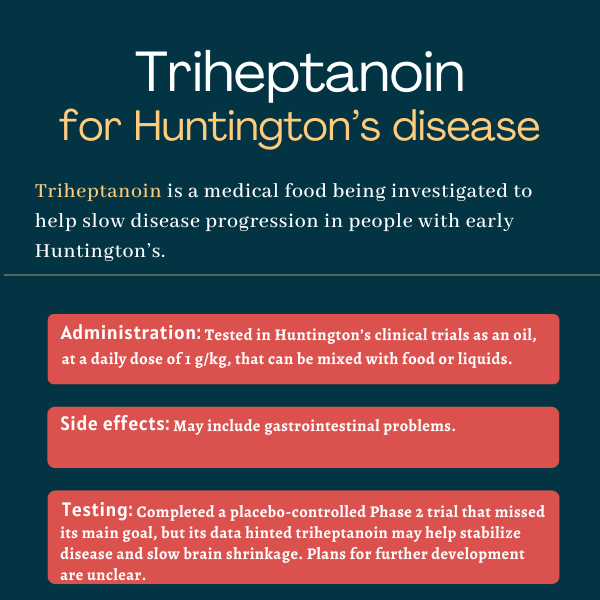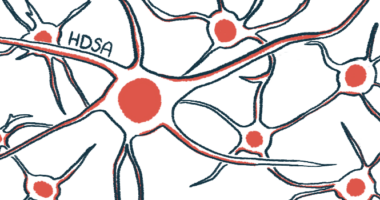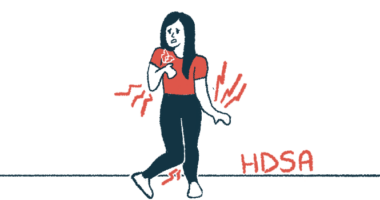Triheptanoin for Huntington’s disease
Last updated Nov. 28, 2024, by Marisa Wexler, MS

What is triheptanoin for Huntington’s disease?
Triheptanoin is a lab-made triglyceride, a type of fatty molecule, being developed to slow the progression of early-stage Huntington’s disease by boosting energy production in the brain.
Inserm Transfert and the Institut du Cerveau-Paris Brain Institute, in France, initiated clinical testing of triheptanoin in Huntington’s and were later joined by Ultragenyx Pharmaceutical.
Triheptanoin was approved in the U.S. in 2020 to treat long-chain fatty acid oxidation disorders, a group of metabolic conditions where the body is unable to properly digest certain fats. The oral therapy is sold by Ultragenyx under the brand name Dojolvi.
Therapy snapshot
| Treatment name: | Triheptanoin |
| Administration: | Being tested in Huntington’s as an oil taken orally |
| Clinical testing: | Completed a placebo-controlled Phase 2 clinical trial that failed to meet its main goal, but showed some promising results; plans for further development are uncertain. |
How does triheptanoin work in Huntington’s disease?
Huntington’s disease is a genetic disorder marked by progressive damage to the brain, which ultimately drives motor and nonmotor symptoms.
The brain requires a lot of energy to function and most of that energy is produced by tiny structures inside cells called mitochondria. In Huntington’s, the brain’s ability to make energy is impaired, and several abnormalities in mitochondria have been reported, which together are thought to contribute to Huntington’s neurodegeneration.
Triheptanoin is a lab-made triglyceride, the most common type of fat in the bloodstream, that is able to act as an anaplerotic compound, meaning it can provide cells with certain metabolic intermediaries that can help with energy production.
Specifically, triheptanoin is metabolized in the intestines to form a molecule called heptanoate that is absorbed into the bloodstream. Heptanoate can enter mitochondria, where it is transformed into propionyl-CoA, a compound that fuels an energy-producing process called the Krebs cycle.
As such, triheptanoin is expected to improve energy production in the brain, which could help ease symptoms and slow the progression of Huntington’s.
How will triheptanoin be administered in Huntington’s disease?
Triheptanoin is available as an oil that can be mixed with semi-solid food or liquids prior to administration orally or through a feeding tube. In Huntington’s clinical trials, triheptanoin oil was taken at a daily dose of 1 gram per kilogram of body weight (g/kg).
Triheptanoin in Huntington’s disease clinical trials
Triheptanoin was tested in people with early-stage Huntington’s in a two-part, proof-of-concept clinical trial and a larger Phase 2 study called TRIHEP3 (NCT02453061).
Proof-of-concept study
The pilot study, conducted at a single French site by the French National Institute for Health and Medical Research (INSERM), was divided into two parts: an initial observational phase named PRO-MH2 (NCT01696708) and an interventional phase, dubbed TRIHEP2 (NCT01882062).
The first part involved nine adults with early Huntington’s and 13 healthy adults who underwent brain imaging to assess brain energy usage with a measure called Pi/PCr ratio. The goal was to confirm the presence of a brain energy deficit in Huntington’s and assess whether this energetic profile showed changes over a month.
Results showed that in healthy people, the Pi/PCr ratio increased by 11% during brain activation due to visual stimulation and returned to rest levels after stimulation, basically reflecting an uptick in energy production when the brain is processing more information.
However, in people with early-stage Huntington’s, the Pi/PCr ratio showed no significant changes with brain stimulation, implying problems with energy generation in the patients’ brains.
TRIHEP2 enrolled five of the patients in the first part along with five new adults with early-stage Huntington’s. All 10 participants underwent brain imaging and clinical evaluation at the study’s start and after a month on triheptanoin oil, at a dose of 1 g/kg per day, that was divided in three to four intakes during meals.
The main goal of this part was to assess changes in brain energy profile after one month of treatment and potential associations with clinical parameters.
Data showed that triheptanoin treatment was generally well tolerated and led to pronounced improvements in brain energy profile, with the Pi/PCr ratio showing a spike during brain stimulation similar to that seen in healthy adults.
These proof-of-concept findings suggest triheptanoin is able to lower the abnormal energy response to brain activation that’s seen in early-stage Huntington’s patients.
Although the pilot study was not designed to assess the treatment’s effect on Huntington’s severity, available data indicated motor symptoms tended to ease after a month on triheptanoin.
TRIHEP3
INSERM launched the larger Phase 2 TRIHEP3 study, which enrolled 100 adults with early-stage Huntington’s disease at two sites, in Paris and in Leiden, the Netherlands. This trial was also supported by Ultragenyx.
For the first six months of the study, half the patients were treated with triheptanoin (1 g/kg/day), while the remaining were given safflower oil as a placebo. Then for the next six months, all were treated with triheptanoin.
Participants who completed the yearlong trial had the option to enter an extension study where all were given triheptanoin for another year. A total of 86 patients completed the yearlong trial and 42 completed the extension.
The study’s main goal was to test if triheptanoin was better than a placebo at slowing shrinkage, or atrophy, of the caudate nucleus, a part of the brain that is strongly affected by Huntington’s, after six months.
Secondary goals were changes in caudate nucleus volume at one and two years, along with changes in other brain imaging measures and clinical measures at six, 12, and 24 months.
Results presented at a scientific meeting in 2021 showed the trial failed to meet its main goal. After six months, there was no significant difference in the rate of caudate nucleus atrophy between the triheptanoin and placebo groups.
Still, promising results were seen in changes in the Unified Huntington’s Disease Rating Scale’s Total Motor Score (TMS), a measure of motor symptom severity, wherein higher scores indicate worse symptoms.
At the end of the yearlong study, patients given triheptanoin for the full year experienced a lower TMS increase than those originally assigned a placebo and who switched to triheptanoin after six months (mean, 0.6 vs. 2.5 points).
While this group difference did not reach statistical significance, it did so when looking at TMS changes in the second six months of the trial. Specifically, those always on triheptanoin saw a mean 0.7-point drop, indicating easing of motor symptoms, while those previously on placebo experienced a mean score increase of 1.9 points.
To further contextualize the findings, one-year TMS results were compared with those from an external group of patients given a placebo for a full year in a separate trial (NCT02336633) that included Huntington’s patients with similar clinical features.
This comparison showed triheptanoin-treated patients had slower disability progression, reflected by a TMS increase of 0.6 compared with a 2.6-point increase in the external placebo group. This difference nearly reached statistical significance. Also, those on triheptanoin had significantly slower caudate atrophy relative to the external placebo group (by 3% vs 6.7%). These findings indicate triheptanoin was associated with clinical stability and a 50% slower rate of caudate atrophy.
In addition, data from patients who completed the extension study indicated that two years on triheptanoin was associated with fewer structural changes in the fibers that connect different brain regions than starting triheptanoin six months later. Improved fiber trophicity was observed in both groups.
Full trial results have not been published to date.

Common side effects of triheptanoin
In clinical testing so far, triheptanoin was found to be generally safe and well tolerated. In the TRIHEP2 study, the only reported side effect was diarrhea and in the placebo-controlled TRIHEP3 trial, the most common side effects were gastrointestinal issues that typically resolved with diet changes.
Full TRIHEP3 results have not yet been published and further studies are needed to determine the therapy’s full safety profile in people with Huntington’s.
Huntington’s Disease News is strictly a news and information website about the disease. It does not provide medical advice, diagnosis or treatment. This content is not intended to be a substitute for professional medical advice, diagnosis, or treatment. Always seek the advice of your physician or other qualified health provider with any questions you may have regarding a medical condition. Never disregard professional medical advice or delay in seeking it because of something you have read on this website.
Recent Posts
- What I want people to stop saying about Huntington’s disease
- HDSA 2025: Dance classes may improve balance in Huntington’s
- HDSA 2025: Long-term care transition requires communication
- Guest Voice: Huntington’s disease is rare, but love isn’t
- HDSA 2025: Observational studies in Huntington’s now enrolling in US
- HDSA 2025: Speakers spotlight Huntington’s clinical trials
- HDSA 2025: Speech therapy can help Huntington’s disease patients
- HDSA 2025: Early planning key for navigating care over time
- HDSA 2025: Psychedelic compound eases depression in mice
- HDSA 2025: Support can help combat Huntington’s disease stigma






